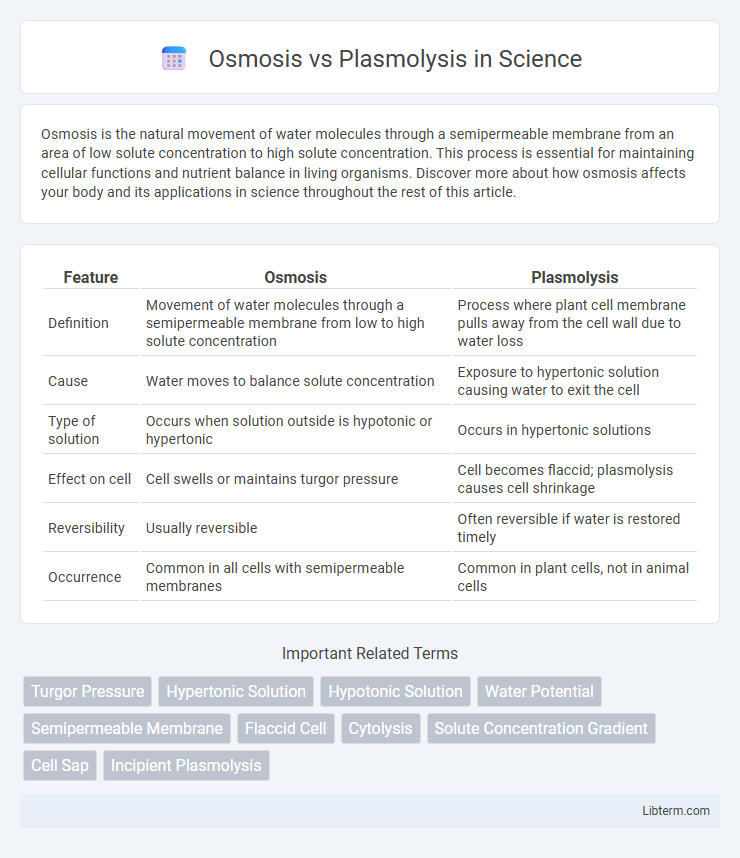Osmosis is the natural movement of water molecules through a semipermeable membrane from an area of low solute concentration to high solute concentration. This process is essential for maintaining cellular functions and nutrient balance in living organisms. Discover more about how osmosis affects your body and its applications in science throughout the rest of this article.
Table of Comparison
| Feature | Osmosis | Plasmolysis |
|---|---|---|
| Definition | Movement of water molecules through a semipermeable membrane from low to high solute concentration | Process where plant cell membrane pulls away from the cell wall due to water loss |
| Cause | Water moves to balance solute concentration | Exposure to hypertonic solution causing water to exit the cell |
| Type of solution | Occurs when solution outside is hypotonic or hypertonic | Occurs in hypertonic solutions |
| Effect on cell | Cell swells or maintains turgor pressure | Cell becomes flaccid; plasmolysis causes cell shrinkage |
| Reversibility | Usually reversible | Often reversible if water is restored timely |
| Occurrence | Common in all cells with semipermeable membranes | Common in plant cells, not in animal cells |
Introduction to Osmosis and Plasmolysis
Osmosis is the passive movement of water molecules across a semipermeable membrane from a region of lower solute concentration to higher solute concentration. Plasmolysis occurs when plant cells lose water in a hypertonic solution, causing the cell membrane to detach from the cell wall. Both processes are vital for understanding water regulation and cell stability in biological systems.
Defining Osmosis: Key Concepts
Osmosis is the passive movement of water molecules across a semipermeable membrane from a region of low solute concentration to a region of high solute concentration, critical for maintaining cellular homeostasis. This process equalizes solute concentrations on both sides of the membrane without energy expenditure, driven solely by osmotic pressure. Understanding osmosis is essential for differentiating it from plasmolysis, which involves the shrinkage of the cell membrane away from the cell wall due to water loss in hypertonic environments.
Understanding Plasmolysis: Basic Principles
Plasmolysis occurs when plant cells lose water through osmosis, causing the cell membrane to shrink away from the cell wall due to a hypertonic external environment. This process is crucial in understanding how water potential differences drive cellular dehydration and affect plant turgor pressure. Unlike osmosis, which refers to the passive movement of water across a semi-permeable membrane, plasmolysis specifically describes the cellular response to water loss in plant cells.
Comparative Mechanisms: Osmosis vs Plasmolysis
Osmosis is the passive movement of water molecules through a semipermeable membrane from a region of lower solute concentration to higher solute concentration, aiming to equalize solute levels on both sides. Plasmolysis occurs when plant cells lose water in a hypertonic solution, causing the plasma membrane to pull away from the cell wall due to water efflux. While osmosis drives water into cells in hypotonic environments to maintain cell turgidity, plasmolysis results from water exiting the cell in hypertonic conditions, leading to cell shrinkage and potential wilting.
Biological Significance of Osmosis
Osmosis is crucial for maintaining cellular homeostasis by regulating the movement of water across semi-permeable membranes, ensuring optimal cell turgor and nutrient balance. Unlike plasmolysis, which results from water loss causing cell shrinkage and potential cell damage, osmosis supports vital processes such as nutrient absorption, waste removal, and maintaining pressure within plant cells. This biological significance of osmosis underpins key physiological functions in both plants and animals, driving cellular hydration and metabolic stability.
Physiological Importance of Plasmolysis
Plasmolysis plays a crucial role in plant cells by illustrating the effects of water loss on cell turgor and maintaining cell integrity under hypertonic conditions. It helps regulate cellular processes by preventing excessive water uptake, thus protecting cells from bursting in saline or drought environments. Understanding plasmolysis is essential for studying plant responses to osmotic stress and improving crop resilience.
Visual Differences: Microscopic Observations
Under microscopic observation, osmosis is characterized by the swelling of plant or animal cells as water molecules move into the cell, causing the cell membrane to press firmly against the cell wall in plant cells. In contrast, plasmolysis exhibits cell shrinkage; the cell membrane pulls away from the cell wall due to water loss, resulting in visible gaps between the membrane and the wall. These distinct visual differences serve as clear indicators to distinguish osmotic swelling from plasmolytic contraction in cells.
Factors Influencing Osmosis and Plasmolysis
The factors influencing osmosis include the concentration gradient of solutes across the semi-permeable membrane, temperature which affects the kinetic energy of water molecules, and the pressure exerted on the solution. In plasmolysis, crucial factors are the concentration of the hypertonic solution causing water to exit the cell, the permeability of the cell membrane, and the structural properties of the cell wall that determine the extent of cell shrinkage. Both processes are heavily dependent on solute concentration differences and the physical characteristics of the cell membrane and surrounding environment.
Real-life Examples in Plants and Cells
Osmosis in plant cells is exemplified by the absorption of water through root hairs, maintaining turgor pressure essential for structural support and nutrient transport. Plasmolysis occurs when plant cells lose water in hypertonic solutions, as seen during salt stress or drought, causing the cell membrane to retract from the cell wall and impair cellular functions. These processes demonstrate critical adaptations plants use to regulate water balance and survive environmental challenges.
Summary: Key Differences and Similarities
Osmosis and plasmolysis are processes involving the movement of water across cell membranes, critical for maintaining cellular homeostasis. Osmosis is the passive diffusion of water from a region of low solute concentration to high solute concentration, whereas plasmolysis occurs when a cell loses water in a hypertonic solution, causing the cell membrane to shrink away from the cell wall. Both processes regulate water balance but differ fundamentally in directionality and cellular impact, with osmosis sustaining cell turgor and plasmolysis leading to cell shrinkage and potential damage.
Osmosis Infographic

 libterm.com
libterm.com